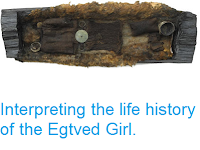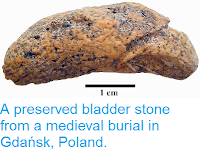The collapse of the Roman Empire in Western Europe triggered a period of political instability across the region, reaching into areas considerably beyond the extent of the Empire at its peak, known as the Migration Period. During this period southern Scandinavia was dominated by a highly hierarchical Iron Age society in which power had been associated with the control of trade routes to the Roman Empire, but which now became reliant on the ability to manage more complex relationships in a time of famine, war and shifting political alliances across northern Europe. This appears to have led to a drop in population centres in southern Scandinavia, with a number of settlements having been abandoned or even showing signs of deliberate destruction during this period.
In a paper published in the journal Antiquity on 24 April 2018, Clara Alfsdotter of the Department of Archaeology at the Bohusläns Museum, and Ludvig Papmehl-Dufay and Helena Victor of the Department of Museum Archaeology at the Kalmar County Museum, describe the results of a series of excavations at the Sandby borg ringfort, on the island of Öland off the southeast coast of Sweden, which was apparently abandoned following a massacre between 400 and 550 AD.
The Sandby borg ringfort has been subject to a number of surveys and excavations since the discovery of pits apparently dug by looters in 2010. The site is located by the shore on the southeastern part of the island, and comprises an area of about 5000 m² enclosed by an oval stone wall interpreted to have been between between four and five metres high. Within this wall an outer ring of houses were constructed against the outer wall, with an inner block of houses separated from this outer ring by a street, an arrangement typical of ringforts on Öland.
Plan of Sandby borg with the identified houses numbered. The overview is based on geophysical surveys, excavations and aerial photographs. Alfsdotter et al. (2018).
Initial metal detectors surveys of the site revealed five caches of jewelry in separate houses within the fort. Each of these caches contained a gilded silver relief brooch with decorations in Salins Style I (animal patterns) and spiral patterns, a style which suggests manufacture a date of between 450 and 510 AD, as well as glass beads, finger rings and silver pendants. These broaches are typical of jewelry owned by aristocratic women of the period, and were probably made locally, but some of the other artifacts, such as millefiori glass beads, silver bell pendants and cowrie shell ornaments, are clearly of non-local origin.
The five gilded relief brooches in silver found in five different deposits in 2010. Daniel Lindskog in Alfsdotter et al. (2018).
Subsequent excavations have exposed about 6 % of the site (i.e. 300 m²), including two complete houses, about half of a third house and parts of six more houses. Human remains were discovered in four of these houses, as well as in the street outside. The excavations have also recovered substantial amounts of ceramics, mostly fragmented but complete, bronze, silver, gold and some iron objects, glass and silver beads, a gilded silver sword pendant, a large millefiori glass bead, a Valentinian III solidus (Roman coin manufactured between 425 and 455 AD), and fragments of a sixth glided silver relief broach. Very little military equipment was recovered from the site, which is surprising given the fortified nature of the site, only handful of arrowheads, one lance-head and two or three unique sword details.
A large millefiori glass sword bead, a Valentinian III solidus and a gilded silver sword pendant found on the floor of house 40. Daniel Lindskog in Alfsdotter et al. (2018).
A great deal of human remains have been found at Sandby borg, which can be attributed to at least 26 individuals (some of the remains are disarticulated), along with the remains of a number of animals.
At least nine individuals were found within one house, 40, five complete skeletons, three of which have been positively identified as adult males, and another two as probably male adolescents, plus the disarticulated remains of at least four more individuals, including a child of 2-5 years and an infant of 18 months-3 years. These disarticulated remains do not appear to have been deliberately dismembered, but rather to have become disarticulated some time after death.
The four adult male skeletons and one of the adolescents show signs of blunt force trauma immediately before death. Three of these skeletons were lying in extended positions, probably indicting instant death, or at least unconsciousness, two had extended bodies but flexed legs, whole one of the adolescents was lying on one side, probably suggestive of a slower death. The other adolescent was flat on their back with their feet on one of the adults, possibly suggesting having fallen backwards over the prone body of the adult. Two of the skeletons were partially disarticulated ans burned, implying a fire either broke out during the course of events that overrun the settlement, or was deliberately set, but burned out before it could spread.
The other houses excavated also contain a number of disarticulated Human remains, as does the street. One house, 52, contains the partially articulated skeleton of an elderly male lying in an extended position face down across the central hearth. This skeleton shows signs of charring, suggesting that the hearth was still lit when he fell onto it. Several other skeletons show signs of violent deaths, including blows to the back and hips (indicative of blows from behind or two one side), but not the facial and forearm injuries typically associated with deaths in battle, suggesting that these individuals were unable to defend themselves for some reason (such as a sudden, overwhelming attack)/
None of the bodies have been identified as female, despite the presence of female jewelry and children in the settlement, both of which indicate women were present, which suggests the women had either left prior to the attack, or were carried of as spoils after it. The presence of so many bodies strongly implies that the settlement was abandoned after the attack, and not subsequently re-entered by survivors of the attack or neighbouring communities, as bodies were typically cremated at the time.
The site also includes a number of articulated and disarticulated animal skeletons, including Dogs, Sheep, Horses and Lambs. The Lambs are particularly interesting, as they are aged 3-6 months, and since all Lambs are born in the spring, can be used to indicate that the attack occured between late spring and early autumn.
See also...
At least nine individuals were found within one house, 40, five complete skeletons, three of which have been positively identified as adult males, and another two as probably male adolescents, plus the disarticulated remains of at least four more individuals, including a child of 2-5 years and an infant of 18 months-3 years. These disarticulated remains do not appear to have been deliberately dismembered, but rather to have become disarticulated some time after death.
One of the nine human skeletons found on the floor level of house 40. This adolescent was found lying on their side. The white arrow points north. Kalmar County Museum in Alfsdotter et al. (2018).
The four adult male skeletons and one of the adolescents show signs of blunt force trauma immediately before death. Three of these skeletons were lying in extended positions, probably indicting instant death, or at least unconsciousness, two had extended bodies but flexed legs, whole one of the adolescents was lying on one side, probably suggestive of a slower death. The other adolescent was flat on their back with their feet on one of the adults, possibly suggesting having fallen backwards over the prone body of the adult. Two of the skeletons were partially disarticulated ans burned, implying a fire either broke out during the course of events that overrun the settlement, or was deliberately set, but burned out before it could spread.
The skeletal remains of two individuals inside house 40. The remains of the young teenager are stretched out, with the feet on top of the pelvis of an adult man, suggesting that the teenager fell backwards over the dead or dying adult. The adolescent (12–15 years old) displays perimortem blunt force on the skull . The western house wall is at the bottom of the picture. The white arrow points north. Kalmar County Museum in Alfsdotter et al. (2018).
The other houses excavated also contain a number of disarticulated Human remains, as does the street. One house, 52, contains the partially articulated skeleton of an elderly male lying in an extended position face down across the central hearth. This skeleton shows signs of charring, suggesting that the hearth was still lit when he fell onto it. Several other skeletons show signs of violent deaths, including blows to the back and hips (indicative of blows from behind or two one side), but not the facial and forearm injuries typically associated with deaths in battle, suggesting that these individuals were unable to defend themselves for some reason (such as a sudden, overwhelming attack)/
None of the bodies have been identified as female, despite the presence of female jewelry and children in the settlement, both of which indicate women were present, which suggests the women had either left prior to the attack, or were carried of as spoils after it. The presence of so many bodies strongly implies that the settlement was abandoned after the attack, and not subsequently re-entered by survivors of the attack or neighbouring communities, as bodies were typically cremated at the time.
The site also includes a number of articulated and disarticulated animal skeletons, including Dogs, Sheep, Horses and Lambs. The Lambs are particularly interesting, as they are aged 3-6 months, and since all Lambs are born in the spring, can be used to indicate that the attack occured between late spring and early autumn.
See also...
Follow Sciency Thoughts on Facebook.











